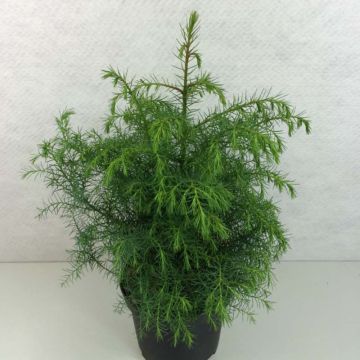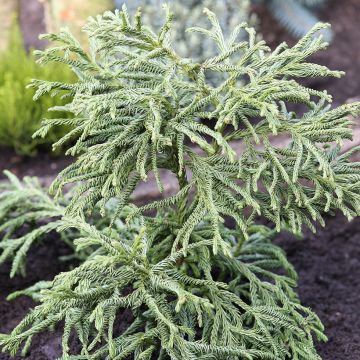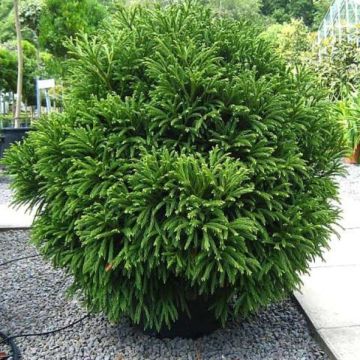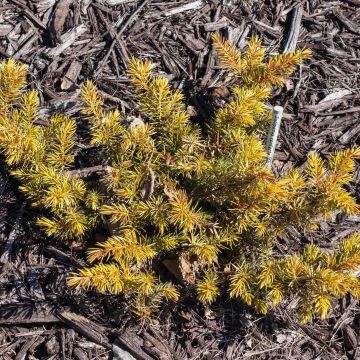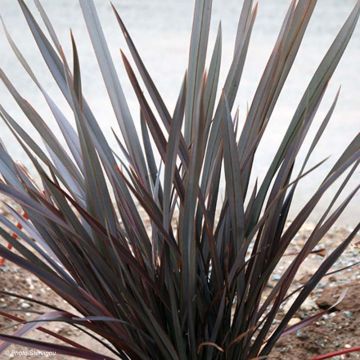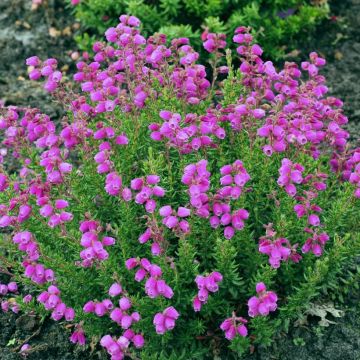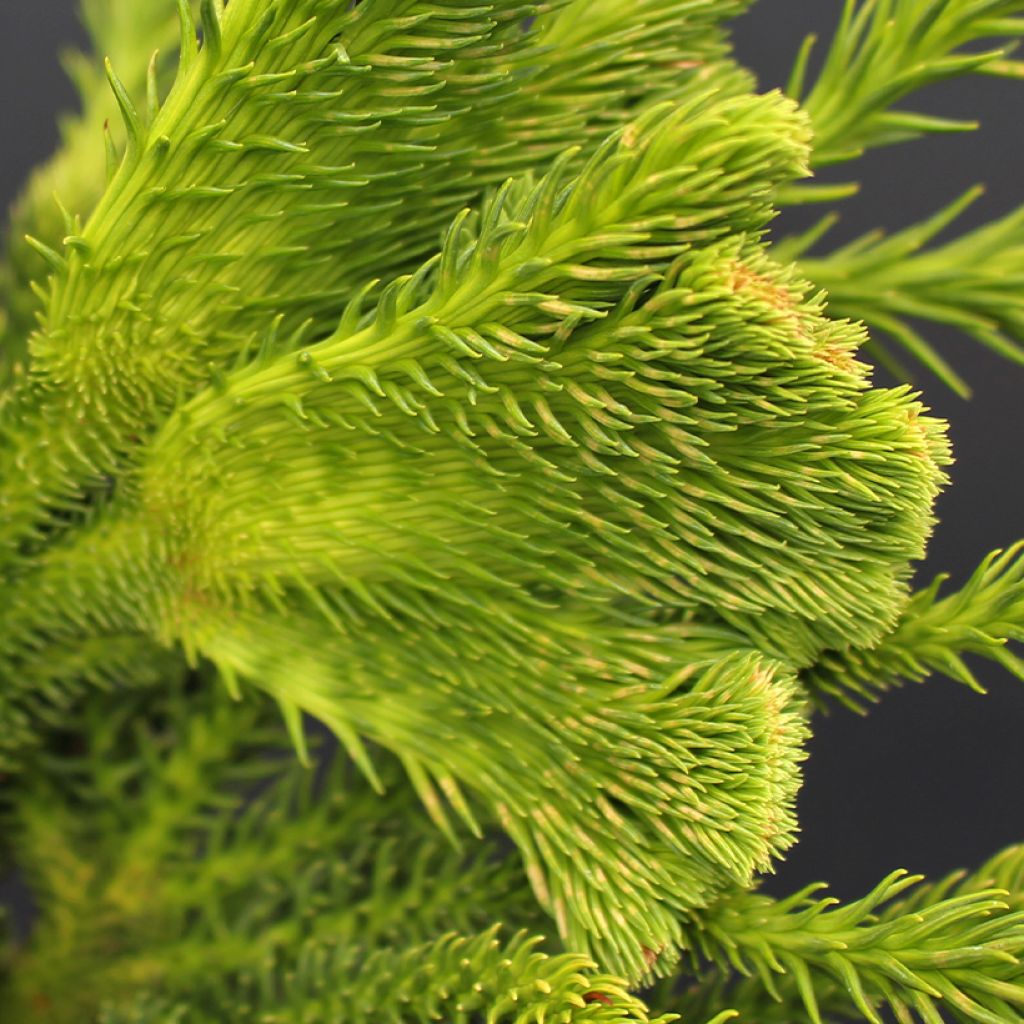

Cryptomeria japonica Tomahawk - Japanese cedar


Cryptomeria japonica Tomahawk - Japanese cedar
Cryptomeria japonica Tomahawk - Japanese cedar
Cryptomeria japonica Tomahawk
Japanese cedar, Japanese redwood
Why not try an alternative variety in stock?
View all →This plant carries a 24 months recovery warranty
More information
We guarantee the quality of our plants for a full growing cycle, and will replace at our expense any plant that fails to recover under normal climatic and planting conditions.
From €5.90 for pickup delivery and €6.90 for home delivery
Express home delivery from €8.90.
Does this plant fit my garden?
Set up your Plantfit profile →
Description
The Cryptomeria japonica 'Tomahawk' is a curious dwarf conifer that has the particularity of developing, at the end of its branches, several young shoots fused together, in the shape of cock's combs. Its habit is compact and rounded, and it remains green all year round. It will not exceed 1.2 m in height. It will find its place in all gardens. Magnificent when planted on its own in a small garden, it will integrate perfectly into a flowerbed or a rockery in a slightly larger garden. It can also be planted in a large container on a terrace. It appreciates full sun or partial shade, sheltered from cold winds, in a well-drained and deep soil.
Originating from Japan and southern China, Cryptomeria japonica is a very tall conifer of the taxodiaceae family. In Japan, it has long been cultivated as a timber tree. It is known as "Sugi" there. This tree, which can reach a height of 25 m, was discovered by E. Kaempfer in 1692 and the first seeds were brought from China to England in the mid-19th century. The Japanese cedar has given rise to numerous cultivars, most often selected for their small size, foliage appearance, or original habit.
The Japanese cedar 'Tomahawk' is a small conifer with a dwarf and globular habit, which can, gradually, reach 1.2 m in all directions. Its branches are short and arranged in a star shape, which gives it a unique appearance, not to mention its cock's comb-shaped tips. Its needles are evergreen and of a beautiful bright green colour. This unique variety deserves a special place in your garden. The 'Tomahawk' variety is the result of a natural mutation that occurred on the Cryptomeria japonica 'Dinger' and is distinguished by its crested shoots.
With its compact habit and its evergreen and green foliage, the Cryptomeria japonica 'Tomahawk' will have a beautiful effect when planted on its own, in a rockery or in a flowerbed. Combine it with other dwarf conifers like Juniperus horizontalis Blue Chip, with its creeping habit and bluish foliage, or Cryptomeria japonica 'Twinkle Toes', with its golden young shoots. Plant it in a large container on a terrace to enjoy its curious foliage.
Report an error about the product description
Plant habit
Foliage
Safety measures
Botanical data
Cryptomeria
japonica
Tomahawk
Taxodiaceae (cupressaceae)
Japanese cedar, Japanese redwood
Cultivar or hybrid
atteinterespiratoire
Cette plante peut entraîner des symptômes allergiques.
Evitez de la planter si vous ou vos proches souffrez de rhinite saisonnière ("rhume des foins").
Davantage d'informations sur https://plantes-risque.info
Other Cryptomeria
Planting and care
The Cryptomeria japonica 'Tomahawk' is ideally planted in a well-drained, deep, moist, and fertile soil. It dislikes excessively dry soils, as well as limestone. Water well and mulch around its base during the first summers to preserve soil moisture. Choose a sunny location (while avoiding scorching sun in the south of France) or a partially shaded area protected from cold winds. Pruning is not necessary, but it tolerates light pruning well. It is an easy-to-grow, cold-resistant bush.
Planting period
Intended location
Care
This item has not been reviewed yet - be the first to leave a review about it.
Evergreen shrubs
Haven't found what you were looking for?
Hardiness is the lowest winter temperature a plant can endure without suffering serious damage or even dying. However, hardiness is affected by location (a sheltered area, such as a patio), protection (winter cover) and soil type (hardiness is improved by well-drained soil).

Photo Sharing Terms & Conditions
In order to encourage gardeners to interact and share their experiences, Promesse de fleurs offers various media enabling content to be uploaded onto its Site - in particular via the ‘Photo sharing’ module.
The User agrees to refrain from:
- Posting any content that is illegal, prejudicial, insulting, racist, inciteful to hatred, revisionist, contrary to public decency, that infringes on privacy or on the privacy rights of third parties, in particular the publicity rights of persons and goods, intellectual property rights, or the right to privacy.
- Submitting content on behalf of a third party;
- Impersonate the identity of a third party and/or publish any personal information about a third party;
In general, the User undertakes to refrain from any unethical behaviour.
All Content (in particular text, comments, files, images, photos, videos, creative works, etc.), which may be subject to property or intellectual property rights, image or other private rights, shall remain the property of the User, subject to the limited rights granted by the terms of the licence granted by Promesse de fleurs as stated below. Users are at liberty to publish or not to publish such Content on the Site, notably via the ‘Photo Sharing’ facility, and accept that this Content shall be made public and freely accessible, notably on the Internet.
Users further acknowledge, undertake to have ,and guarantee that they hold all necessary rights and permissions to publish such material on the Site, in particular with regard to the legislation in force pertaining to any privacy, property, intellectual property, image, or contractual rights, or rights of any other nature. By publishing such Content on the Site, Users acknowledge accepting full liability as publishers of the Content within the meaning of the law, and grant Promesse de fleurs, free of charge, an inclusive, worldwide licence for the said Content for the entire duration of its publication, including all reproduction, representation, up/downloading, displaying, performing, transmission, and storage rights.
Users also grant permission for their name to be linked to the Content and accept that this link may not always be made available.
By engaging in posting material, Users consent to their Content becoming automatically accessible on the Internet, in particular on other sites and/or blogs and/or web pages of the Promesse de fleurs site, including in particular social pages and the Promesse de fleurs catalogue.
Users may secure the removal of entrusted content free of charge by issuing a simple request via our contact form.
The flowering period indicated on our website applies to countries and regions located in USDA zone 8 (France, the United Kingdom, Ireland, the Netherlands, etc.)
It will vary according to where you live:
- In zones 9 to 10 (Italy, Spain, Greece, etc.), flowering will occur about 2 to 4 weeks earlier.
- In zones 6 to 7 (Germany, Poland, Slovenia, and lower mountainous regions), flowering will be delayed by 2 to 3 weeks.
- In zone 5 (Central Europe, Scandinavia), blooming will be delayed by 3 to 5 weeks.
In temperate climates, pruning of spring-flowering shrubs (forsythia, spireas, etc.) should be done just after flowering.
Pruning of summer-flowering shrubs (Indian Lilac, Perovskia, etc.) can be done in winter or spring.
In cold regions as well as with frost-sensitive plants, avoid pruning too early when severe frosts may still occur.
The planting period indicated on our website applies to countries and regions located in USDA zone 8 (France, United Kingdom, Ireland, Netherlands).
It will vary according to where you live:
- In Mediterranean zones (Marseille, Madrid, Milan, etc.), autumn and winter are the best planting periods.
- In continental zones (Strasbourg, Munich, Vienna, etc.), delay planting by 2 to 3 weeks in spring and bring it forward by 2 to 4 weeks in autumn.
- In mountainous regions (the Alps, Pyrenees, Carpathians, etc.), it is best to plant in late spring (May-June) or late summer (August-September).
The harvesting period indicated on our website applies to countries and regions in USDA zone 8 (France, England, Ireland, the Netherlands).
In colder areas (Scandinavia, Poland, Austria...) fruit and vegetable harvests are likely to be delayed by 3-4 weeks.
In warmer areas (Italy, Spain, Greece, etc.), harvesting will probably take place earlier, depending on weather conditions.
The sowing periods indicated on our website apply to countries and regions within USDA Zone 8 (France, UK, Ireland, Netherlands).
In colder areas (Scandinavia, Poland, Austria...), delay any outdoor sowing by 3-4 weeks, or sow under glass.
In warmer climes (Italy, Spain, Greece, etc.), bring outdoor sowing forward by a few weeks.




































